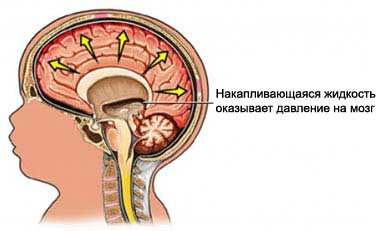Ventriculoperitoneal shunt in a child
Description ventriculoperitoneal shunt
Ventriculoperitoneal shunt – operation, in which a doctor inserts a drainage tube (catheter) brain. The tube is then directed into the peritoneal cavity. The procedure is performed to remove excess fluid, accumulates in the brain, into the abdominal cavity, where it can be absorbed. The entire tube is under the skin, and it is not visible from the outside.
Reasons for ventriculoperitoneal shunt
This type of shunt is used to treat hydrocephalus. It occurs when the accumulation of too much liquid in the brain. The presence of excess fluid can lead to high blood pressure, which can damage sensitive brain tissue. The shunt is used to drain excess fluid and reduce pressure on the brain.

Possible complications of ventriculoperitoneal shunt
Complications are rare, but the procedure does not guarantee the absence of risk. If you plan to ventriculoperitoneal shunt, you need to know about possible complications, which may include:
- The shunt is not fulfilling its functions;
- Cephaledema;
- Blood clot or bleeding in the brain;
- Infection in the shunt or brain;
- Damage to brain tissue;
- Reaction to anesthesia (eg, dizziness, lowering blood pressure, breathlessness).
How is the ventriculoperitoneal shunt?
Preparation for the procedure
Before the surgery, the doctor may have to be imposed or carried out following:
- Neurological examination, to determine the functionality of the nervous system of the child. Testing includes an assessment of the mental state, as well as motor and sensory abilities;
- MRT or CT brain – Some pictures of the baby will help the doctor plan surgery;
- Ask your doctor some questions – Can the child take prescribed medication before surgery? What degree of recovery of brain function can be expected from the operation? How soon will symptoms start to improve? What are the signs, that the shunt is not functioning properly?
- Ask your child to eat or drink before surgery. The doctor can give a child about this guide, depending on the age of the child. The ban on meal can vary from 6 to 12 hours before surgery.
Anesthesia
Used general anesthesia, which blocks and supports the patient's pain during the operation in sleep. Administered intravenously in the arm or hand.
Procedure ventriculoperitoneal shunt
The throat is set snorkel, to help your child breathe during surgery. Antiseptic cleans the scalp and abdomen. The doctor makes a small incision in the scalp and abdomen. The skull runs a small hole, through which a catheter is inserted into the child's brain. The catheter is then carried out under the skin down to the abdomen, and the second end is introduced into the peritoneal cavity. The incisions are closed with stitches, they bandage.
Immediately after ventriculoperitoneal shunt
After surgery, the child will be sent to the recovery room for observation. If you did not have complications, breathing tube will be removed. Then the child will be moved to a hospital room to recover.
How long will ventriculoperitoneal shunt?
1-1,5 hours.
Ventriculoperitoneal shunt – Will it hurt?
Anesthesia prevents pain during surgery. After the surgery, the doctor will give pain medicine, to ease the pain.
Average length of stay
The child may be in the hospital for 3-7 days. Your doctor may prolong hospitalization, If there are complications.
Care after ventriculoperitoneal shunt
Care in a hospital
- Your child, perhaps, I need to lie on your back 24 hours after surgery;
- Controlled by heart rate of the child, blood pressure, respiratory rate and condition of the brain;
- The child will receive nutrition through an IV, until it is ready to eat and drink on their own;
- Regularly check that the shunt;
- They can be treated with antibiotics. As necessary, given pain medication.
Home Care
After returning the child home, follow these steps, to ensure the normal recovery:
- Follow your doctor's instructions on bathing. Not allowed to lower the child's head in water or wash her hair until healing is complete;
- Check the incision area, to ensure that no infection;
- Do not let your child touch the cuts.
Contact your doctor after ventriculoperitoneal shunt
After discharge from the hospital need to see a doctor, if the child came of any of the following symptoms:
- Kryvosheya;
- Headache;
- Irritability;
- Signs of infection, including fever and chills;
- Redness, edema, increased pain, bleeding or discharge from incisions;
- Vomiting (which may be a sign of unemployed shunt);
- Pain, which does not pass after taking the designated child pain medicine;
- Vision problems;
- Drowsiness;
- Confusion;
- Delays in development;
- Anorexia.
We must immediately seek medical help in the event of the following symptoms:
- Frequent or shortness of breath;
- Blue or gray skin color;
- The child does not wake up or does not respond to external stimuli;
- Convulsions.
